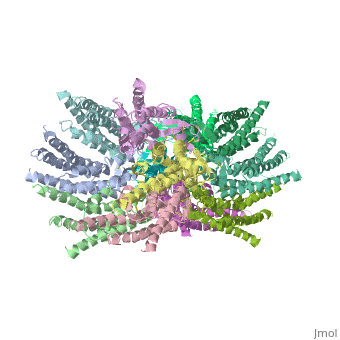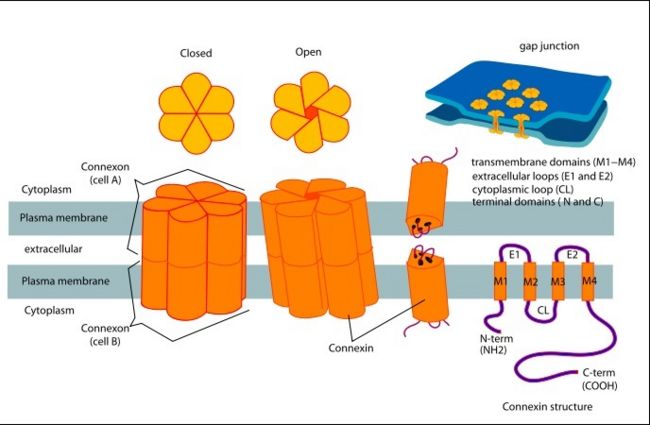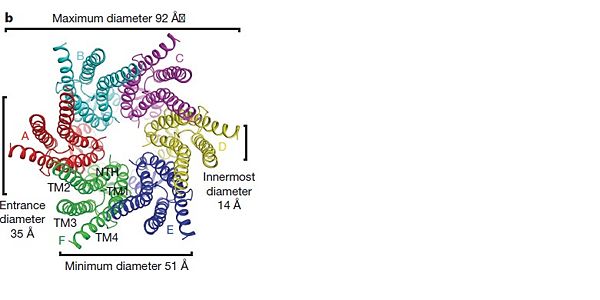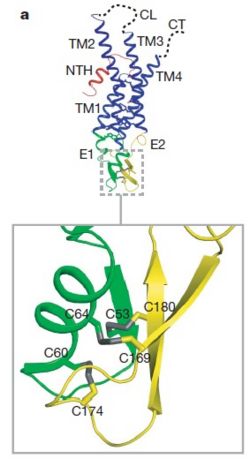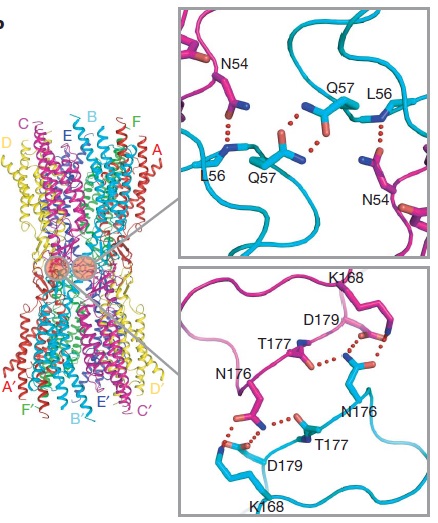Connexin
From Proteopedia
(Difference between revisions)
| Line 5: | Line 5: | ||
| - | [[image:co.jpg | thumb | | + | [[image:co.jpg | thumb |650px | center | The overall connexon's structure]] <ref>http://en.wikipedia.org/wiki/Connexin</ref> |
| Line 18: | Line 18: | ||
==Connexin structure== | ==Connexin structure== | ||
| - | <scene name='70/701426/Connexin_structure2/1'>connexins</scene> are integral transmembranal proteins which consist of α-helical domains in the <scene name='70/701426/Tm1-tm4/1'>transmembranal segments</scene> (TM1-TM4) , <scene name='70/701426/E1_and_e2/1'>two extracellular loops</scene> (E1 and E2), a cytoplasmic loop, an N-terminal helix (NTH), and a C-terminal segment. Each connexin consists of 227 amino acids, and <scene name='70/701426/Conxoxn_structure/1'>Six units of connexin</scene> form a hexamerical assembly , known as <scene name='70/701426/Connexin_26_basic_structure/3'>a connexon</scene>, or a <scene name='70/701426/Connexin_26_basic_structure/5'>hemmichannel</scene>, which delineates <scene name='70/701426/Pore/1'>an aqueous pore</scene> with a minimum diameter of ∼1.2 nm. | + | <scene name='70/701426/Connexin_structure2/1'>connexins</scene> are integral transmembranal proteins which consist of α-helical domains in the <scene name='70/701426/Tm1-tm4/1'>transmembranal segments</scene> (TM1-TM4), <scene name='70/701426/E1_and_e2/1'>two extracellular loops</scene> (E1 and E2), a cytoplasmic loop, an N-terminal helix (NTH), and a C-terminal segment. Each connexin consists of 227 amino acids, and <scene name='70/701426/Conxoxn_structure/1'>Six units of connexin</scene> form a hexamerical assembly, known as <scene name='70/701426/Connexin_26_basic_structure/3'>a connexon</scene>, or a <scene name='70/701426/Connexin_26_basic_structure/5'>hemmichannel</scene>, which delineates <scene name='70/701426/Pore/1'>an aqueous pore</scene> with a minimum diameter of ∼1.2 nm. |
When two hemichannels from adjacent cells dock and join, leaving a gap of ∼2–3 nm, they may form a gap junction which spans the two plasma membranes and allows the exchange of cytoplasmic molecules with size up to ∼1 kDa. | When two hemichannels from adjacent cells dock and join, leaving a gap of ∼2–3 nm, they may form a gap junction which spans the two plasma membranes and allows the exchange of cytoplasmic molecules with size up to ∼1 kDa. | ||
| Line 25: | Line 25: | ||
The transmembrane region of the channel is 38Å thick.TM2 extends about 19Å from the membrane surface into the cytoplasm. The extracellular region of the connexon extends 23Å from the membrane surface and interdigitates to the opposite connexon by 6Å, resulting in the intercellular ‘gap’ of 40Å. The extracellular lobes are not protruding so much, as indicated by the structural analyses of split gap junction channels with atomic force microscopy and electron microscopy. The relatively flat lobes could be attributed to the conformational change of the extracellular region induced by the docking of two connexons. The diameter of the connexon is biggest at the cytoplasmic side of the membrane, 92Å , and smallest at the extracellular side, 51Å . | The transmembrane region of the channel is 38Å thick.TM2 extends about 19Å from the membrane surface into the cytoplasm. The extracellular region of the connexon extends 23Å from the membrane surface and interdigitates to the opposite connexon by 6Å, resulting in the intercellular ‘gap’ of 40Å. The extracellular lobes are not protruding so much, as indicated by the structural analyses of split gap junction channels with atomic force microscopy and electron microscopy. The relatively flat lobes could be attributed to the conformational change of the extracellular region induced by the docking of two connexons. The diameter of the connexon is biggest at the cytoplasmic side of the membrane, 92Å , and smallest at the extracellular side, 51Å . | ||
Viewed from the top, the channel looks like a ‘hexagonal nut’ with a pore in the centre .The diameter of the pore is about 40Å at the cytoplasmic side of the channel, narrowing to 14Å near the extracellular membrane surface and then widening to 25Å in the extracellular space.<ref name='Structure'/> | Viewed from the top, the channel looks like a ‘hexagonal nut’ with a pore in the centre .The diameter of the pore is about 40Å at the cytoplasmic side of the channel, narrowing to 14Å near the extracellular membrane surface and then widening to 25Å in the extracellular space.<ref name='Structure'/> | ||
| - | [[Image:distances b.jpg | thumb | | + | [[Image:distances b.jpg | thumb |600px | center | Top view of the Cx26 gap junction channel]] |
==Structure of the cx26 protomer:== | ==Structure of the cx26 protomer:== | ||
As mentioned before <scene name='70/701426/Connexin_structure/1'>the connexin</scene> [http://en.wikipedia.org/wiki/Promoter_(genetics) protomer] has four transmembrane (TM1–4), two extracellular loops , a cytoplasmic loop, an N-terminal helix (NTH), and a C-terminal segment. Cx26 forms a typical four-helix bundle in which any pair of adjacent helices is antiparallel. The major pore-lining helix TM1 is inclined, so that the pore diameter narrows from the cytoplasmic to the extracellular side of the membrane, and ends in a short [http://en.wikipedia.org/wiki/310_helix 3<sub>10</sub> helix]. | As mentioned before <scene name='70/701426/Connexin_structure/1'>the connexin</scene> [http://en.wikipedia.org/wiki/Promoter_(genetics) protomer] has four transmembrane (TM1–4), two extracellular loops , a cytoplasmic loop, an N-terminal helix (NTH), and a C-terminal segment. Cx26 forms a typical four-helix bundle in which any pair of adjacent helices is antiparallel. The major pore-lining helix TM1 is inclined, so that the pore diameter narrows from the cytoplasmic to the extracellular side of the membrane, and ends in a short [http://en.wikipedia.org/wiki/310_helix 3<sub>10</sub> helix]. | ||
| - | The extracellular loop E1 contains a [http://en.wikipedia.org/wiki/310_helix 3<sub>10</sub> helix] at the beginning and a short α-helix in its C-terminal. E2, together with E1, contains a short antiparallel β-sheet and stretches over E1, forming the outside <scene name='70/701426/Connexon_bachbone/1'>wall</scene> of the connexon. Six conserved cysteine residues, three in each loop, form intramolecular disulphide bonds between E1 and E2 Most of the prominent intra-protomer interactions are in the extracellular part of the transmembrane region, The interactions between the two adjoining connexons of the gap junction channel, which involve both E1 and E2 .[[image:E1.jpg | thumb | center | 250px]] | + | The extracellular loop E1 contains a [http://en.wikipedia.org/wiki/310_helix 3<sub>10</sub> helix] at the beginning and a short α-helix in its C-terminal. E2, together with E1, contains a short antiparallel β-sheet and stretches over E1, forming the outside <scene name='70/701426/Connexon_bachbone/1'>wall</scene> of the connexon. Six conserved cysteine residues, three in each loop, form intramolecular disulphide bonds between E1 and E2 Most of the prominent intra-protomer interactions are in the extracellular part of the transmembrane region, The interactions between the two adjoining connexons of the gap junction channel, which involve both E1 and E2 .[[image:E1.jpg | thumb | center | 250px | Disulfide bonds between two extracellular loops in the Cx26 promoter]] |
The N-terminal half of E2 seems rather flexible and its amino-acid sequence varies greatly among connexins . The C-terminal half of E2 begins with a 310 turn is followed by a conserved Pro-Cys-Pro motif that reverses its direction back to TM4. Most of the prominent intra-protomer interactions are in the extracellular part of the transmembrane region . Arg 32 (TM1) interactswithGln 80 (TM2),Glu 147 (TM3), and Ser 199 (TM4). Two hydrophobic cores around Trp 44 (E1) and Trp 77 (TM2) stabilize the protomer structure. Ala 39 (TM1), Ala 40 (TM1), Val 43 (E1) and Ile 74 (TM2) contribute to the first hydrophobic core around Trp 44, and Phe 154 (TM3) and Met 195 (TM4) form the second core with Trp 77 . In the intracellular part of the transmembrane region, Arg 143 (TM3) forms hydrogen bonds with Asn 206 (TM3) and Ser 139 (TM3) .<ref name='Structure'/> | The N-terminal half of E2 seems rather flexible and its amino-acid sequence varies greatly among connexins . The C-terminal half of E2 begins with a 310 turn is followed by a conserved Pro-Cys-Pro motif that reverses its direction back to TM4. Most of the prominent intra-protomer interactions are in the extracellular part of the transmembrane region . Arg 32 (TM1) interactswithGln 80 (TM2),Glu 147 (TM3), and Ser 199 (TM4). Two hydrophobic cores around Trp 44 (E1) and Trp 77 (TM2) stabilize the protomer structure. Ala 39 (TM1), Ala 40 (TM1), Val 43 (E1) and Ile 74 (TM2) contribute to the first hydrophobic core around Trp 44, and Phe 154 (TM3) and Met 195 (TM4) form the second core with Trp 77 . In the intracellular part of the transmembrane region, Arg 143 (TM3) forms hydrogen bonds with Asn 206 (TM3) and Ser 139 (TM3) .<ref name='Structure'/> | ||
| - | [[image:bonds.jpg | thumb | center | | + | [[image:bonds.jpg | thumb | center | 500px | Intracellular interactions]] |
Revision as of 06:51, 2 August 2015
| |||||||||||
Proteopedia Page Contributors and Editors (what is this?)
Safaa Salah Hussiesy, Michal Harel, Doaa Naffaa, Jaime Prilusky
